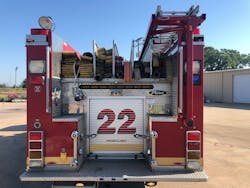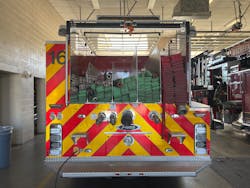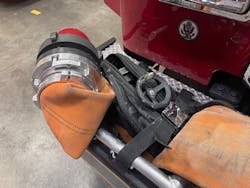Designing an effective engine company apparatus can be quite a daunting task. Today’s fire service requires apparatus to respond to myriad alarm types. This necessitates significantly greater amounts of equipment than what was required previously.
The process of trying to maximize a pumper apparatus’ versatility while also ensuring that it performs its primary fire suppression roles efficiently requires a delicate balance of understanding the compromises of apparatus design and knowing how to prioritize decisions.
Compromise
One of the most important concepts of designing a piece of apparatus often is underestimated or overlooked by firefighters: Every decision that’s made about an apparatus by an apparatus committee comes with a compromise. Very few design decisions don’t have some sort of an effect on some other component of the apparatus. If every design element on an engine isn’t thoroughly vetted to determine what will be given up to gain that particular element, you quickly will get lost in a maze of options that have tons of versatility but very little effectiveness.
For this reason, apparatus committees must have a list of priorities to consult when making design decisions. There must be some sort of organization to how decisions are made throughout the design process. Developing this list shouldn’t be slighted, and a department shouldn’t focus only on simple priorities but also the types of tasks that an apparatus will perform.
Prioritizing
In my department, when designing apparatus, we utilize a system that breaks decisions down by priority and type of task. When it comes to pumpers, hoseline deployment for fire suppression is the number one priority. Every decision that we make about pumper apparatus design is evaluated to determine whether it has a negative effect on hoseline deployment. If it does have an effect, we weigh out how much of an effect that it has and whether we’re willing to make that sacrifice.
An example of the consideration of a low-intensity task is the location of a booster reel. In our department, the booster reel is used mostly for small rubbish fires and grass fires and for mop up after a structure fire. Although this type of hoseline deployment might dominate responses for some departments, there typically is time to slow down and be more deliberate when stretching the booster line for these types of fires. In contrast, stretching a 1¾-inch hoseline for fire attack with the report of persons trapped is a very high-intensity operation. Most likely, members are so mission-focused that there’s a greater likelihood that they could miss important steps to ensure safe deployment.
On our department’s older pumpers, the booster reel was located in a rear compartment that was below the hosebed, a very common location. Although this made the booster reel extremely convenient to deploy and put away, the location raised the hosebed height, which made hoseline deployment from the bed more challenging. In essence, we made the low-intensity operation extremely easy—members didn’t have to step up off of the ground—but we forced members to step up during high-intensity operations, where a missed step is much more likely.
Crosslay, hosebed or bumper?
There always is much discussion about the best placement for primary attack lines. Some departments swear by the versatility of the crosslay for their primary attack lines. Others utilize rear-exiting hoselines from the bed. Still others, particularly some on the East Coast, believe that bumper lines are the most efficient deployment location. For primary attack lines, a mixture of the crosslay, rear-exiting hoselines from the bed and bumper lines is most ideal—if you can facilitate all of them.
If it’s possible to appease everyone who is involved without significant detriment to a higher priority function or an excessive expense, why wouldn’t you strive to give the members as many options as possible? I certainly am not advocating for a jack-of-all-trades mentality when it comes to designing a pumper, but my department found that having all three of the aforementioned deployment locations can be done with very little detriment to the consideration of high-intensity tasks.
Preconnect or static?
If you look at new pumper apparatus that were put into operation in recent years, you can see how popular the preconnected hoseline has emerged to be, particularly in the crosslay location. Although they vary, the length of most preconnected hoselines is in the range of 150–300 feet, with 200 feet being the most common.
Preconnected hoselines certainly aid in the speed and simplicity of deployment. For many years, they were the hoseline of choice in my department. However, we found the preconnected hoseline to be lacking when we needed to extend it beyond its 200-foot length.
Although the majority of a department’s responses might be well within the reach of a preconnect, almost every department responds to a hotel, apartment building, retail store or house that has a long setback, where a longer line is needed. It’s imperative that every pumper has at least one alternative hoseline, readily available, for when the preconnect won’t reach. When my department extended its preconnects, we found that, because a priority wasn’t placed on how well that this extended line deployed, our success with it was less than desirable. This turned out to be one of the reasons why we completely reevaluated hoseline deployment options—and developed a system that made us faster and more versatile than our previous preconnected hoselines (see “Engine Company Operations: The Midwestern Static Load,”).
Size does matter
The medium-diameter attack line, aka the 2½-inch, is one of the most often overlooked hoselines. For many years, as hose manufacturers worked to increase the flows of smaller-diameter attack lines, many departments believed that it no longer was imperative to maintain a medium-diameter attack line. Although evolving hose design and construction has increased flows, the fires that we face, fueled by modern construction and furnishings, also changed, and the need for 2½-inch handlines is as important as it ever was.
Again, almost every department’s response area has some type of commercial occupancies, particularly buildings of Type II construction. Apparatus must be equipped with a way to initiate fire attack on these structures as quickly and efficiently as 1¾-inch attack lines provide. This is another area where an apparatus committee’s determination of high-intensity or low-intensity is important in the placement of lines and how easy that their deployment should be.
Water supply perspective
Remember, the primary mission of an engine company is to place fire suppression lines in service and to make sure that its members have an uninterrupted supply of water. The importance of the “uninterrupted supply of water” element drove my department more toward rear-exiting static attack lines as opposed to previous cross-laid preconnects.
My department covers a fairly large response area. Having a second-arriving pumper establish a water supply in a timely manner isn’t always feasible. This can be particularly true when deploying 2½-inch hoselines, because an established water supply is necessary earlier in the operation with those than is the case with 1¾-inch attack lines.
With the static bed, we have the ability to drop an attack line(s) at the fire and drive the pumper to the hydrant to establish its own water supply. This not only establishes the water supply earlier in the operation but frees up a second-due pumper for a different assignment.
Our static beds afford us the ability to put four attack lines of either 1¾- or 2½-inch in service readily. We even can drop a large-diameter hose at the front of the structure if we anticipate the need to supply a truck company in a defensive capacity with aerial master streams.
A rural department can perform a similar operation when it responds to residential fires that are in farmhouses that have a long set back. Traditionally, such a department might drop a supply line at the road and drive to the farmhouse, which facilitates a second-arriving pumper to set up a portable tank operation to supply water to the first-due engine. However, if you flip this configuration and drive to the farmhouse, drop the attack line and drive back to the roadway, the first-due pumper is in a position to drop a portable tank in front of the engine, right off of the road. Incoming tenders can drop their supply and never have to turn off of the roadway.
One-stop-shop approach
Placing all necessary appliances proximal to the hose location aids in rapid hoseline deployment. Whether it’s an attack line off of the rear that would require a reducer or a soft suction off of the front bumper or side of the apparatus, a hoseline should be a one-stop shop, with any reducers, adaptors, sections of hose or other tools that are required for an operation located where the hoseline is deployed. This little change can speed up how quickly lines are in service, and it lessens the potential of the mistake of not grabbing the correct adaptors when in a rush.
Test your pumper approach
Each department must make every effort to ensure that however it configures its apparatus, the department maximizes its investment and the vehicle best serves the community. My hope is that this article aids you in finding ways to maximize hoseline deployment while maintaining the versatility that’s required of a modern-day fire apparatus.
Hosebed Height
As the capabilities of engine apparatus grew, the heights of hosebeds continued to climb, and it seems that only in recent years has it become popular to bring hosebed heights back down to a realistic level.
If at all possible, any high-intensity function on the fireground should be able to be performed without members having to step up to or down from the apparatus. Some of the most common fireground injuries are slips and falls, so why would you design an apparatus that requires members who are in full turnout gear to step up and down just to pull a hoseline? In addition, it’s more likely that firefighters will be less safety conscious when in high-intensity operations, which means that they might step off of the tailboard hurriedly and fall.
Booster tank capacity can be one of the most significant obstacles to having a low hosebed, but it’s possible if made a priority. Butler County Fire District #8 in Douglass, KS, did just that with its recent pumper purchase. The department has a 1,000-gallon booster tank as well as a hosebed that facilitates attack line deployment from ground level. Furthermore, it utilizes webbing that’s attached to the supply line, so members can pull the supply line without having to step onto the tailboard.
The Value of a Hosebox
Most pumper specifications for hosetrays and hosebeds are based off of a hose size and capacity. Although manufacturers have generic dimensions, to determine the necessary area for hose load capacity, these aren’t hose manufacturer-specific. There is quite a bit of variance in the overall size of hose, not just between manufacturers but even between models from one manufacturer.
It is money well spent to go to a lumber yard and mock up a hosebed yourself. It doesn’t have to be full size, but at least getting an idea of the general dimensions that are required for your particular hose will pay dividends when it comes time to approve drawings and to take delivery of a pumper.
Of course, hoseboxes can prove to be a valuable training tool for newer members who are learning to pull and reload hose.
About the Author
Mark Misek
Mark Misek is a captain with the Wichita, KS, Fire Department (WFD), where he has spent 17 years of his 23-year fire service career. He has been involved in apparatus design and specification for the WFD for the past 11 years. Misek spent more than three years in WFD's Training Division, where he was instrumental in the development of its Engine Operator Academy. Misek currently is assigned to Truck 5 in the northeast part of the city.




